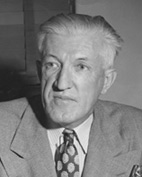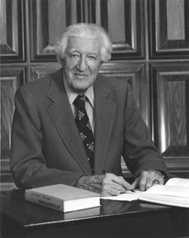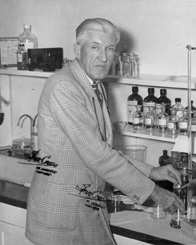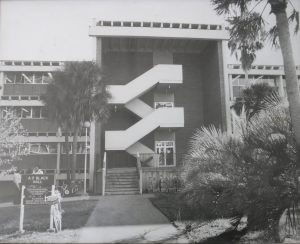An Environmental Engineering Scientist
His Contributions to Water Chemistry
Written by
Mathew D. Guerrie, M.E. and
Joseph J. Delfino, Ph.D., Professor
Department of Environmental Engineering Sciences 2002
INTRODUCTION

Alvin Percy (A.P.) Black was born in Blossom, Texas, on August 30, 1895. He graduated from Paris High School in 1913 and four years later was awarded a bachelor’s degree by Southwestern University (Texas). After performing graduate work at Harvard, he received his Ph.D. in water chemistry from the University of Iowa.
He served in the Army during World War I. Upon discharge from the Army in 1919, he came to the University of Florida, where his initial position was as Assistant Professor of Chemical Engineering. He held many subsequent positions throughout his years of service at the university, including chairman of the Department of Chemistry. After serving as a professor at the University of Florida for 47 years, he retired on June 30, 1966 as Research Professor Emeritus of Chemistry and Bioenvironmental Engineering (the latter a predecessor of the current Department of Environmental Engineering Sciences).
During his career, he was the major professor for over 50 master’s and doctoral graduates and the chairman of many major University committees.
The Board of Regents honored Dr. Black by attaching his name to the 38,000 square foot building constructed in 1967 that was designed to house the Department of Environmental Engineering Sciences.
Dr. Black was the principal or contributing author of over 200 technical papers and received many awards for his outstanding contributions. He served on the editorial boards of several publications in the water works and public health fields.
He was a key member of the American Water Works Association (AWWA) from 1929 until his death in 1980, serving as vice president in 1948 – 49 and as president from 1949 – 1950. Dr. Black served as president of the Florida Public Health Association in 1944 and president of the Southern Association of Science and Industry in 1954. He also served the Federal government as a consultant to the Office of Saline Water of the U.S. Department of the Interior.
Countless awards in the water field were bestowed on Dr. Black, including the Fuller Award, the Goodell Prize, the Water Purification Division Award, and the Diven Medal. His research in the area of water quality and treatment resulted in many major contributions to the field. This was recognized by the AWWA when they designated him as the first recipient of their A.P. Black Research Award in 1968.
Dr. Black was exceptionally successful in the private sector, serving as a consultant to many international, national, and state organizations concerned with water quality, water treatment, and public health. He founded Black Laboratories, which later became Black, Crow, and Eidsness, Consulting Engineers. The company eventually became a part of CH2M Hill, a major international consulting firm.
He served four terms as a member of the College of Electors of the Hall of Fame for Great Americans and was listed in numerous reference books, including Who’s Who in America, Who’s Who in Engineering, and American Men of Science. He was a member of many social and honorary societies, including Alpha Tau Omega, Alpha Chi Sigma, Alpha Epsilon Delta, Alpha Zeta, Phi Kappa Phi, Sigma Tau, Sigma Xi, Tau Beta Pi, Gamma Sigma Epsilon, and Florida Blue Key. He died on February 23, 1980 at the age of 84.
[Back to Top]Chemistry of Coagulation

Dr. Black‘s writings focused on, but were not limited to, water chemistry and treatment, including fluorides in water, the nature of organic color in water, basic mechanisms of coagulation, determination of low turbidities and the preparation of a turbidity standard, and the removal of radioisotopes from water by coagulation. In 1958, his research group introduced microelectrophoresis as a new analytical tool for the study of the basic mechanism of coagulation. This new and effective technique was utilized in many laboratories in the United States and elsewhere.
Dr. Black was also instrumental in contributing to topics such as the effectiveness of polyelectrolyte coagulant aids and the activity of silica gels. One of his first published works, in 1933, focused on the formation of floc using ferric coagulants in water treatment. He reported on the ways that natural waters containing sulfate, chloride, sodium, and calcium ions affected floc formation using ferric salts at differing pH levels.
In addition, he studied aluminum sulfate as a coagulant, and in 1933 presented a case for the standardization of jar test procedures to achieve accurate data for plant operations. He evaluated various stirring devices and argued for standardization of such factors as the sample size, container size and shape, mixing speed and time, and the criteria for optimum dosage.
Dr. Black was a true pioneer in the field of water softening. He helped increase public awareness of carbonate and noncarbonate hardness. In 1958, he elucidated the fine points of lime-soda softening and the use of calcium oxide for the treatment of hard water.
In the field of electrophoretic theory, Dr. Black’s contributions were unmatched in his time. He and his co-authors reported that electrophoresis (the movement of particles in an electric field) was a valuable tool for the better understanding of coagulation.
[Back to Top]Chemistry of Organic Matter

Dr. Black incorporated electrophoresis technology into extensive research involving waters containing organic matter. His 47 years at the University of Florida provided him with access to natural waters high in organic matter in close proximity to his laboratory in Gainesville.
His work with fulvic acids increased understanding of their complexities, through solubility relationships, chemical spot tests, and infrared absorption spectra, and he reported that ozone was more effective than chlorine or chlorine dioxide in removing fulvic acids from water.He studied the removal of organics from waters using ferric sulfate, and reported a method for optimal conditions for removing organic color from relatively soft, colored waters. Ferric sulfate proved to be a very effective coagulant when compared to alum, over a broad range of pH levels.
[Back to Top]
Water Policy and Other Interests
Dr. Black was instrumental in the initiation of work towards sustainable water use in Florida. He wrote about the extensive quantities of surface and underground freshwater available in Florida. He discussed how the discharge of wastes and their chemical constituents had created many difficulties in securing safe water supplies for Florida communities by the late 1930s. Because Dr. Black was a highly respected water scientist and engineer, he influenced several key pieces of environmental legislation.
He was instrumental in the early development of ground water law. He discussed and wrote on the issue in terms of common-law doctrine, reasonable use, prior appropriation, and groundwater classifications. He called for legislation that recognized all groundwater as public waters.
On the introduction of fluoride to public waters to improve dental health, Dr. Black wrote: “All available evidence has indicated that the fluoridation of public water supplies is in the interest of group health and the chemists of America stand ready, as they always have and always will, to participate with the members of the dental profession in its practical realization.” He later defended his comments when called on to refute early critics of fluoridation.
Dr. Black was keenly aware of the need for adequate water conservation, and was in a unique position to have a significant impact on the future of water conservation. In the years following World War II, he focused attention on the conservation of water and indicated that through effective policy and science, water availability could be manipulated and controlled.
His propensity for sound, forward thinking is evident in an article that discussed the water resources of the southern United States. He argued for the need to accumulate long-term basic data and the importance of water reuse, artificial recharge, and desalination, issues which are still very relevant today. The increasing popularity of water reuse can be seen at the University of Florida, which uses treated wastewater for irrigation on campus. Ground water recharge has also become popular in many locations throughout the United States and elsewhere. It is an option under consideration to help solve the problem of the restoration of the Everglades.Other areas in which Dr. Black contributed exceptional writings included salt water intrusion, where he was one of the first to call for governmental and public intervention, and the advantages of swimming pool disinfection using iodine in place of chlorine. He found that iodine was often superior to chlorine when compared on the basis of halogen residual and applied dosage requirements, as well as the lack of odors, tastes, or irritations associated with iodine. While this idea did not stand the test of time, he reported no negative impacts on pool water color resulting from required iodine dosages. Chlorine still remains the disinfectant of choice.Dr. Black helped integrate polymers and polyelectrolytes into water treatment. He recognized their ability to enhance water treatment due to the size of the molecules and their high exchange capacities. He helped change the techniques used for the measurement of low turbidity levels. He reported that the turbidity measurement technique of the day (the Jackson candle turbidimeter) should incorporate electrical photometers to measure light scattering at low angles, a technology that is now widely employed.
[Back to Top]
SUMMARY

Dr. Black’s successes were not limited to research. He was an accomplished author, consultant, business owner, and public servant. His direct and indirect contributions to many of Florida’s municipal water treatment plants were highlighted in countless newspaper articles. Dr. Black served as the engineer representative and consulting chemist for the Fort Myers, Florida, Water Treatment Plant constructed between 1935 and 1938. His expertise and supervision greatly contributed to the success of the innovative plant, which incorporated water softening and some of the first activated carbon filters. He was also in charge of the chemical control and chemical operation of the St. Augustine, Florida, softening plant when it was completed in 1938.
There is likely no other person who contributed as much to the field of water chemistry and water treatment in Florida as well as in the nation than Dr. A.P. Black. His contributions to the University of Florida were also quite extensive.
Recognizing these facts, in 1978 the University of Florida conferred on him an Honorary Doctor of Science degree.
[Back to Top]REFERENCES
Bartow, Edward and A.P. Black. 1933. “Formation of Floc by Ferric Coagulants.” Journal of Industrial and Engineering Chemistry 25: 898-903.
Black, A.P. 1934. “Coagulation with Iron Compounds.” Journal of the American Water Works Association 26: 1713-8.
Black, A.P. 1939. “Reforming Florida Waters: Why Treatment is Needed – Results Obtained at a Few of the Plants in the State.” Water Works Engineering (June).
Black, A.P. 1946. “Water Conservation in Florida: Part I.” Economic Leaflets of the University of Florida 5.
Black, A.P. 1947. “Basic Concepts in Ground Water Law.” Journal of AWWA 39: 989-1000.
Black, A.P. 1952. “The Chemist Looks at Fluoridation.” Journal of the American Dental Association 44: 137-44.
Black, A.P. 1955. “The Water Resources of the South.” Bulletin of the Southern Research Institute 8: 13-24.
Black, A.P. 1956. “Salt Water Encroachment – A Water Resource Problem.” Water Works Engineering 109: 338-42.
Black, A.P. 1958. “The Chemistry of Water Softening by the Lime-Soda Process.” Water Works Engineering 3: 678-83.
Black, A.P. 1960. “Polymers and Polyelectrolytes.” Water Works Engineering 113: 982.
Black, A.P., A.M. Buswell, F.A. Eidsness and A.L. Black. 1957. “Review of the Jar Test.” Journal of AWWA 49: 1914-24.
Black, A.P. and R.F. Christman. 1963. “Chemical Characteristics of Fulvic Acids.” Journal of AWWA 55: 897-912.
Black, A.P. and S.A. Hannah. 1965. “Measurement of Low Turbidities.” Journal of AWWA 57: 901-16.
Black, A.P., J.B. Lackey and E.W. Lackey. 1959. “Effectiveness of Iodine for the Disinfection of Swimming Pool Water.” American Journal of Public Health 49: 1060-8.
Black, A.P., O. Rice and E. Bartow. 1933. “Formation of Floc by Aluminum Sulfate.” Journal of Industrial and Engineering Chemistry 25: 811-5.
Black, A.P. and H.C. Robert. 1938. “New Supply for Fort Meyers, Florida – Treated for Color, Iron, and Hardness Correction.” Water Works Engineering (April 27).
Black, A.P., J.E. Singley, G.P. Whittle and J.S. Maulding. 1963. “Coagulation of Color with Ferric Sulfate.” Journal of AWWA 55: 1347-66.
Black, A.P. and D.G. Willems. 1961. “Electrophoretic Studies of Coagulation for Removal of Organic Color.” Journal of AWWA 53: 589-603.
Pilipovich, J.B., A.P. Black, F.A. Eidsness and T.W. Stearns. 1958. “Electrophoretic Studies of Water Coagulation.” Journal of AWWA 50: 1467-82.
Singley, J.E. and C.-L. Chen, eds. Collected Works of A.P. Black 1933-1966. Gainesville, Florida: University of Florida, 1966.
[Back to Top]